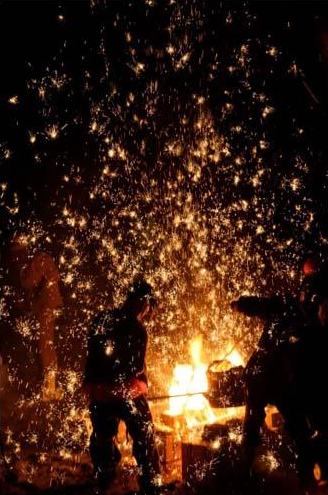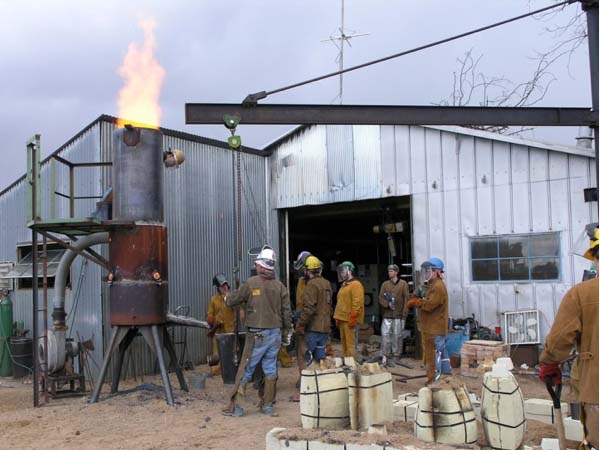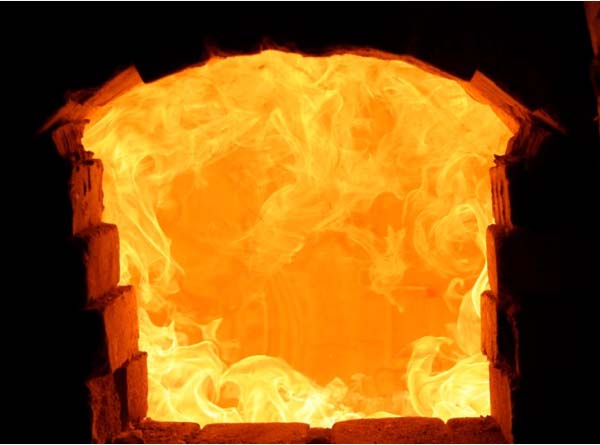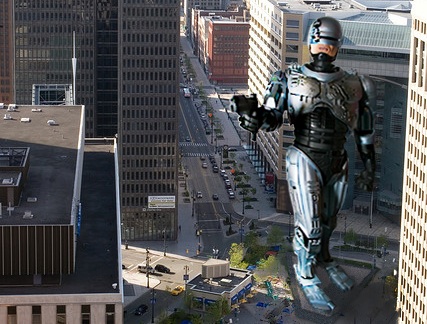 An iron pour from Westbrook’s performance at the University of West Georgia’s Art Incend event in October 2008.Photo: Casey WestbrookImagine a 10-foot-high steel bong filled with industrial grade coke that spews fire like Mordor and reaches temperatures hot enough to turn your radiator into a pool of molten slag. In the background, dimly illuminated by orange flames, Old Detroit at night. Just across the street, its most potent symbol of urban decay: Michigan Central Station, a 230-foot tall Beaux Arts monolith gutted like the carcass of some prehistoric animal, empty since Amtrak abandoned it in 1998.
An iron pour from Westbrook’s performance at the University of West Georgia’s Art Incend event in October 2008.Photo: Casey WestbrookImagine a 10-foot-high steel bong filled with industrial grade coke that spews fire like Mordor and reaches temperatures hot enough to turn your radiator into a pool of molten slag. In the background, dimly illuminated by orange flames, Old Detroit at night. Just across the street, its most potent symbol of urban decay: Michigan Central Station, a 230-foot tall Beaux Arts monolith gutted like the carcass of some prehistoric animal, empty since Amtrak abandoned it in 1998.
Rising from the privately owned land at its feet, poured on-site from an ad-hoc furnace, Detroit’s very own Robocop statue. Two tons of scrap iron formed into a larger-than-life-sized monument to the redemption of this city — the largest in America to consistently make the list of the country’s most dangerous metropolises.
Like the old man in the 1987 Paul Verhoeven film said: “Detroit has a cancer, and that cancer is crime.” Who better to trepan the skull of Detroit’s inner city and pour off the sick within than agent Murphy: part man, part machine, all cop?
That’s the vision of artist Casey Westbrook, the sculptor and furnace builder who will realize the Robocop statue. It’s up to the mayor of Detroit whether the statue will tower over a public square, as a tourist draw and an avatar of every American city’s ability to triumph over de-industrialization, or whether it will stand on the privately owned land already on offer, a plot owned by the nonprofit Imagination Station. But whether the statue will be built is apparently up to the internet. They’ve bestowed it on Detroit, whether the city wants it or not.
Westbrook’s biggest pour ever consisted of a 25-ton spectacular for artist Matthew Barney’s Cremaster cycle. Next to that, creating a Robocop statue the size of Yao Ming is “not a big deal,” says Westbrook. That doesn’t mean the process itself — the statue will literally be poured on-site, rather than being shipped in from a foundry as is the rule with nearly all statues — won’t be astonishing to behold.
 A one-ton yield furnace built with Aaron McCaffery at Kansas State University.Photo: Casey Westbrook
A one-ton yield furnace built with Aaron McCaffery at Kansas State University.Photo: Casey Westbrook
“I’ve never had a [furnace-building] workshop where the community didn’t walk away in awe,” says Westbrook. “The [pour] process itself, just watching it, is spectacular. There are flames shooting everywhere; fire everywhere and massive amounts of anticipation.
The process is relatively simple — Westbrook has built small scale furnaces from little more than a metal trashcan — but extraordinarily dangerous for someone who doesn’t know what they’re doing. (Westbrook is one of the most knowledgeable on-site furnace builders in the world, and has done hundreds of successful pours.) It begins with a tall furnace full of coke — a special, super energy-dense form of coal that is 99 percent carbon. Get that burning, and temperatures inside the furnace tower go north of 3,000 degrees F, hot enough to liquefy your cast iron cookware.
 The furnace will reach a temperature in excess of 3,000 degrees F, like this one at UWG.Photo: Casey Westbrook
The furnace will reach a temperature in excess of 3,000 degrees F, like this one at UWG.Photo: Casey Westbrook
Westbrook and his assistants tend the pour with little more protection than a suit of Kevlar armor and a healthy respect for the potentially lethal nature of their art. “Safety is always the first concern,” says Westbrook.
Once two tons of molten scrap iron has collected in massive cylinders at the bottom of the furnace, the artist will unplug them like a vintner hammering the bung out of a cask, and the metal will gush directly into the mold. It’s likely Robocop will be cast upside-down, his outstretched arms reaching for the ground as if to brace his mass against a fall. A day or two later, once he’s cooled, they’ll knock off the mold with hammers and chisels and the world’s greatest cop will thunder to earth like Han after he was frozen in Carbonite. Then he’ll be readied for a crane-assisted lift onto his ultimate home, a pedestal with some kind of suitably inspiring inscription. [Ed. Note: How about “This is the Motor City. This is what we do.“]
Westbrook knows that, the successful internet-based fundraising campaign notwithstanding, not everyone in Detroit is a fan of this statue. He has deep ties in the local artist community, however, and to the extent possible, he hopes to involve the community in the process of creating the statue itself. Much of his work as a furnace builder has consisted of collaborating with schools, communities, and even adolescents who want to learn his craft.
His methods are also a nod to Detroit’s industrial past and present. “The process I utilize goes back to what the Ford plant is still utilizing,” says Westbrook. Ford has one of the only industrial-scale blast furnaces still in operation in the U.S.; all the rest have been dismantled and shipped to Asia. It’s just one more dimension of the powerful symbolism Westbrook’s Robocop statue will evoke.
“[Critics have said] ‘It’s a futuristic robot figure created to save the people of Detroit,” says Westbrook. “‘But why should we acknowledge that we need saving?'” But with local artists and a casting procedure borrowed from the auto trade, the statue could represent Detroit — the city Hollywood once postulated could be rescued only by superhuman intervention — in the process of saving itself.




